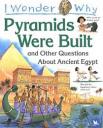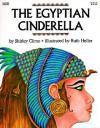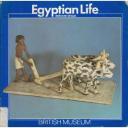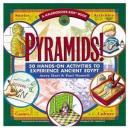This post discusses resources for the second grade Virginia SOL 2.1. In this unit, students learn about the contributions that ancient Egypt has made to the modern world. Specifically, students study how Egypt helped to develop, and influenced, writing, architecture and a few inventions like paper, the 365 day calendar, and the clock. The following books, websites and extra resources are designed to fit this second grade curriculum, but are varied in difficulty so that they can be differentiated for many different levels of students.
Books
I Wonder Why the Pyramids Were Built: And Other Questions About Ancient Egypt
By Miranda Smith
I Wonder Why the Pyramids Were Built: And Other Questions About Ancient Egypt is a useful resources as an introduction to ancient Egypt as it gives a general overview about the lives and practices of ancient Egyptians. It provides child friendly explanations about tricky subjects like embalmment and mummification while still being an overall funny and entertaining book because of the many “ancient Egypt” jokes. Enjoyable illustrations accompany the text so that students can see what typical Egyptians looked like, and how the landscape and architecture of the time appeared.
By Shirley Climo and illustrated by Ruth Heller
The Egyptian Cinderella tells the familiar Cinderella story with an ancient Egyptian twist. In this version, the Greek slave girl, Rhodopis, is saved from her plight by marrying the Pharaoh, with a little help from the Egyptian god Horus. Students will enjoy this story because they can relate it to what they already know about Cinderella and can compare the similarities and differences between the traditional fairy tale and this Egyptian version. While still being entertaining, this Cinderella story manages to inform students about every day Egyptian life, from the existence and roles of slaves and pharaohs to Egyptian mythology and religion.
By Miriam Stead
This book is an excellent classroom resource because it provides examples and descriptions of ancient Egyptian life based upon artifacts currently found in the British Museum. Therefore, this book is different from most books on ancient Egypt because it shows real photographs of real Egyptian objects. Egyptian Life discusses many aspects of the everyday ancient Egyptian experience such as food, family, society, clothing and religion. In this way, this book is a good starting point for students’ comparisons of their modern lives to the lives of ancient Egyptians.
By Peter Manuelian
Hieroglyphs from A to Z is similar to the traditional alphabet books, where each letter is given a page and a sentence using a word that begins with that letter, yet it is different in that the letters are also represented in Egyptian hieroglyphs and the sentences are about Egyptian topics. This book serves as a good introduction to the study of hieroglyphics because it provides a comparison between the letters that students are used to, and their ancient Egyptian counterparts. This book presents the ancient Egyptian writing system in an easy to understand format, and also shares a few facts about Egyptian life and mythology.
By George Hart
Ancient Egypt, from the Eyewitness book series, is a virtual encyclopedia of Egyptian knowledge geared towards elementary aged students. This book combines illustrations, photographs and diagrams to explain tricky and interesting subjects like, what the inside of a pyramid looks like, why the ancient Egyptians dressed the way they do, and how the ancient Egyptians made paper. This book may use some vocabulary that is beyond the second grade level, so it may need to be used as a teacher-guided resource or as a tool for differentiation but it provides an expanse of knowledge on practically any topic that you can think of when it comes to ancient Egypt.
Websites
This site, geared at upper elementary school students, explains topics like the gift of the Nile, the land of the dead, the pharaoh, the Rosetta Stone and Cleopatra. It provides detailed maps and clear explanations of why each of these topics is so important to any study of ancient Egypt. The wording might be a little hard for some second graders to understand, and the site is mostly text-based, so this would be a great site for a teacher-led Webquest or class activity where the teacher could guide students’ reading.
This site would be a wonderful resource for any class studying ancient Egypt since it provides a wealth of information about everything and anything Egypt related. It provides links to information on hieroglyphics, gods, mummies, the Nile, pharaohs, pyramids, Egyptian literature, art, history and more. Teachers and students could use this site to find anything that they might want to know about ancient Egypt, but again, this site may be difficult for second graders to navigate, because it is so expansive, so if students use this resource it should be guided by the teacher.
The British Museum-Ancient Egypt
This website is published by the British Museum’s Egyptology Department but is intended for an elementary audience. It has information about Egyptian life, geography, gods and goddesses, mummification, pharaohs, pyramids, time, trades and writing. This site would be especially useful in light of the SOL because of its explanations about the development of the clock and writing. Each topic contains a story and an exploration link, for example, in the temple section students can “explore” the inside of a temple. This site is easy to navigate so students could traverse it by themselves.
A to Z Kids Stuff- Ancient Egypt
This website acts as an introduction to the history and contributions of ancient Egypt. It discusses the different Egyptian kingdoms and their time periods, as well as Egyptian inventions and some brief information about prominent pharaohs. At the bottom of the page are listed fun activities that students could do to help them learn about ancient Egypt. Since this site is only one page long it would be an easy way for students to learn about ancient Egypt on their own.
Children’s University of Manchester- Ancient Egypt
This website is produced by the University of Manchester as a child’s guide to ancient Egypt. It provides interactive activities that students can do online, like, explore ancient Egypt, Giza pyramid panorama, the Egyptian number system, writing in hieroglyphics, make a mummy and more. These activities have easy to understand directions and are fun ways to explain topics about ancient Egypt.
Other Resources
Why did the Egyptians build the tombs and pyramids? Movie
This movie, presented by BBC Learning Zone Class Clips, shows footage of the pyramids in Egypt and explains why the ancient Egyptians first began to develop the pyramids. It explains the different types of pyramids, which pharaohs preferred which type of pyramid and how Egyptians used the natural resources available to them to design and create the pyramids.
Southlands Elementary Ancient Egypt WebQuest
This WebQuest, produced by Southlands Elementary School, takes students on an internet tour of ancient Egypt to learn about topics like daily life, the sphinx, the Egyptian calendar, hieroglyphics, the pharaohs, the pyramids, the Rosetta Stone and mummification. This WebQuest would be a great review of a unit on Ancient Egypt; it uses clear directions and simple links to keep students from being confused or overwhelmed. The other unique thing about this WebQuest is that it asks students to develop their higher-level thinking by asking questions like “write down some differences between poor and rich Egyptians”, rather than simply asking all explicit questions.
By Christos Kondeatis
This book combines pull out activities and pop-up diagrams to explain the mysteries of ancient Egypt. There are board games, pop-up pyramids, an ancient Egyptian mask and many more interactive and tactile activities to keep students entertained while they are learning. This pack would be a great way to introduce students to a unit on ancient Egypt, or for use as a center activity, or just as something for the class to read together. It provides a lot of information in a very fun package.
Pyramids: 50 Hands on Activities to Experience Ancient Egypt
By Avery Hart
This book provides educators with many different activities for students to learn about ancient Egypt. There are activities about making mummies, designing Egyptian clothes, discovering what the ancient Egyptians ate, playing Egyptian games like tug of war, and more. This book encourages students to “think like Egyptians”, so they should complete the activities using resources and materials that the ancient Egyptians would have had, which adds a unique twist to simple games and projects. These activities are not just for fun, however, they are very educational and include a lot of factual information that students must understand in order to complete the activities, which makes for an excellent resource for both students and teachers alike.







